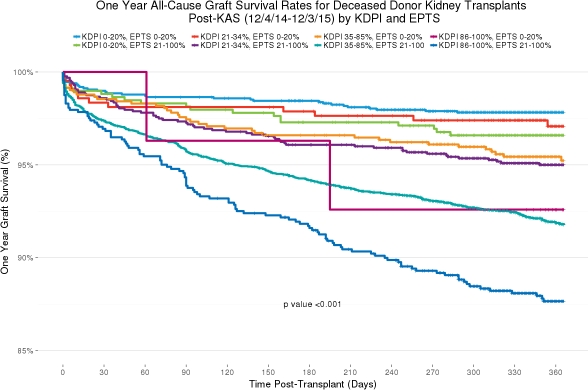One-Year Graft Survival for Longevity Matched Kidneys in the Post-KAS Era
1United Network for Organ Sharing, Richmond, VA
2University Hospitals Cleveland Medical Center, Cleveland, OH
3Carolina's Healthcare, Charlotte, NC
4Emory University, Atlanta, GA.
Meeting: 2018 American Transplant Congress
Abstract number: B88
Keywords: Graft survival, Kidney transplantation, Survival
Session Information
Session Name: Poster Session B: Kidney Deceased Donor Allocation
Session Type: Poster Session
Date: Sunday, June 3, 2018
Session Time: 6:00pm-7:00pm
 Presentation Time: 6:00pm-7:00pm
Presentation Time: 6:00pm-7:00pm
Location: Hall 4EF
One of the key goals and achievements of KAS was to make better use of available kidneys by improving longevity matching between donor kidneys and recipients. However, early analysis of graft survival for transplants occurring in the first year post-KAS (12/4/2014–12/3/2015) have shown a slight reduction in overall graft survival compared to pre-KAS.
One-year unadjusted graft survival was examined by kidney donor profile index (KDPI, %) [0-20, 21-34, 35-85, 86+] and recipient estimated post-transplant survival (EPTS, %) [0-20, 21+] per the Kaplan-Meier method to estimate early results of longevity matched kidneys post-KAS. Missing EPTS is allocated as 21+. Rates were compared and multiple comparisons were accounted for by a Holm adjusted log-rank p-value.
One-year graft survival decreased as KDPI increased, from 97% for 0-20 to 88% for 86+. Similarly, one-year graft survival decreased as EPTS increased, from 97% for 0-20 to 92% for 21+.
When examined together, graft survival rates varied significantly (p<0.0001). Specifically, rates were lower for KDPI 21-34, EPTS 21+ (p=0.0016), KDPI 35-85 regardless of EPTS (0-20 p=0.0174, 21+ p<0.0001), and KDPI 86+, EPTS 21+ (p<0.0001) versus KDPI 0-20, EPTS 0-20.
Other comparisons, seen below, highlight the variability between low KDPI, low EPTS matched kidneys and high KDPI, high EPTS matched kidneys.
Longevity matched kidneys yield favorable early graft outcomes. Not shown here, these rates also vary by recipient pre-transplant time on dialysis. Early results of longevity matching under KAS appear to have achieved its goal, but more analysis is needed to understand how other characteristics interact with KDPI and EPTS regarding kidney graft outcomes.
CITATION INFORMATION: Wilk A., Aeder M., Casingal V., Turgeon N. One-Year Graft Survival for Longevity Matched Kidneys in the Post-KAS Era Am J Transplant. 2017;17 (suppl 3).
To cite this abstract in AMA style:
Wilk A, Aeder M, Casingal V, Turgeon N. One-Year Graft Survival for Longevity Matched Kidneys in the Post-KAS Era [abstract]. https://atcmeetingabstracts.com/abstract/one-year-graft-survival-for-longevity-matched-kidneys-in-the-post-kas-era/. Accessed December 6, 2025.« Back to 2018 American Transplant Congress


